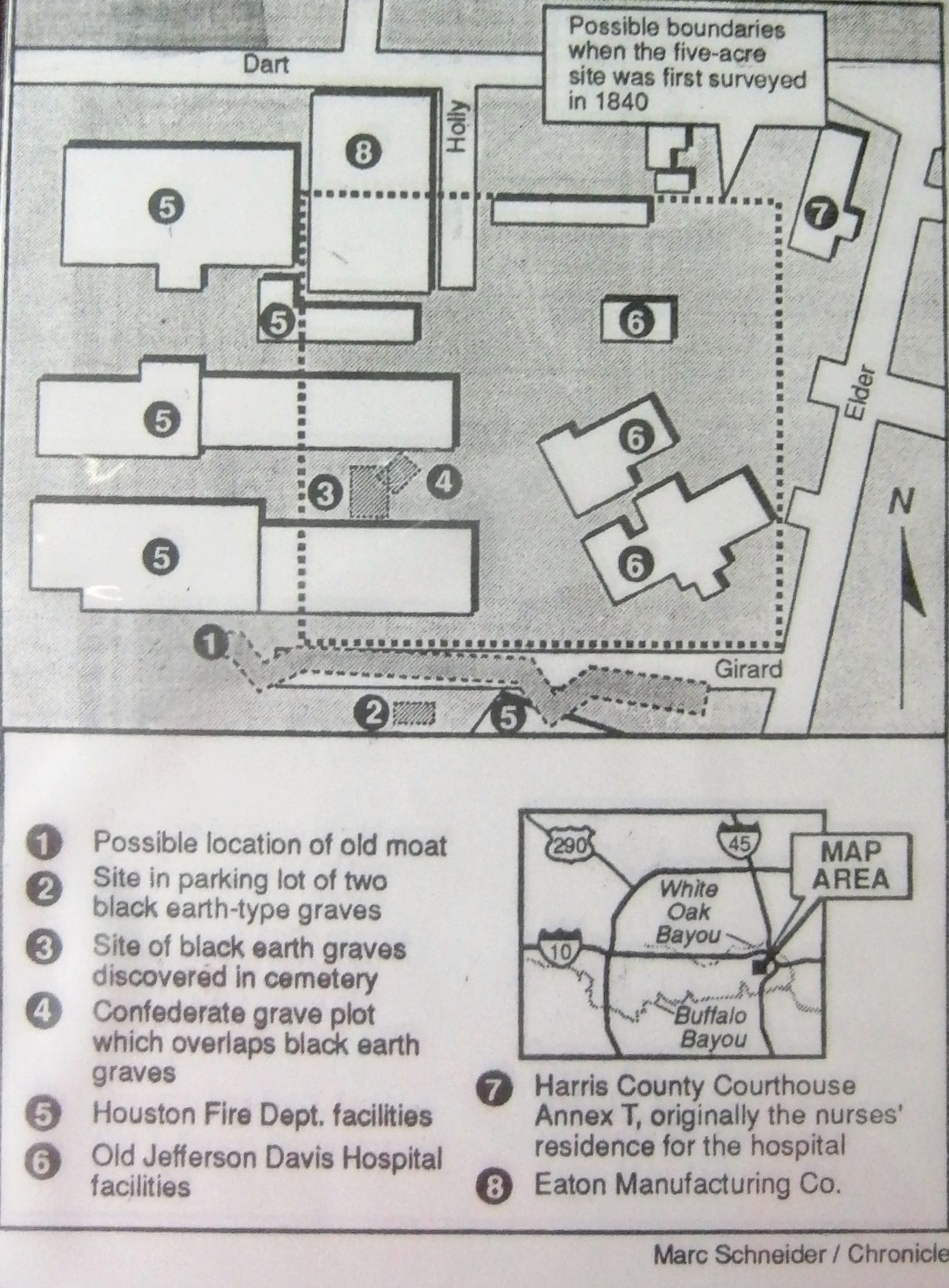English Colonists Graveyard
1010 Girard
Established 1600s ?
© 0.25 acres
40 – 60 graves
“…undiscover’d country from whose bourne, no traveler returns.”
Hamlet – William Shakespeare
 Were the English the first Europeans to discover Texas? Did they erect a settlement near Houston? Do we need to add the Union Jack to the Six Flags Over Texas? If Dr. David Brown, chairman of the University of Houston anthropology department, is correct that 60 “black earth” graves accidently discovered when the City dug a utility trench northwest of downtown near the intersection of Girard and Elder between Buffalo and White Oak bayous, the answer is a resounding YES! There are several pieces of evidence that strongly suggest Dr. Brown might be on to something.
Were the English the first Europeans to discover Texas? Did they erect a settlement near Houston? Do we need to add the Union Jack to the Six Flags Over Texas? If Dr. David Brown, chairman of the University of Houston anthropology department, is correct that 60 “black earth” graves accidently discovered when the City dug a utility trench northwest of downtown near the intersection of Girard and Elder between Buffalo and White Oak bayous, the answer is a resounding YES! There are several pieces of evidence that strongly suggest Dr. Brown might be on to something.
First are the graves themselves.
In the 16th century the bubonic or “Black Plague” was ravaging Europe. At that time it was not known the epidemic was caused by fleas from rats infesting the dirty straw beds used in the Middle Ages. Common wisdom said the disease was spread by contact with bodily fluids and vapors emanating from the corpses. Therefore in 1563 Queen Elizabeth I ordered the London Common Council to enact legislation thought to improve burial practices. These regulations included: burial in a woolen shroud (rather than those made of linen or cotton) not in a coffin and that graves be refilled with “new mould” (fresh organic topsoil from gardens or the floor of a nearby forest). The visual effect of the new soil made the grave look darker that the surrounding earth, thus the name “black earth” graves. The theory was this mixture directly covering the body would create a “compost” effect that would break down the corpse more rapidly thus cease extended exposure to the fluids and malodorous vapors. These practices were carried out not only in the British Isles but the colonies as well. In the case of our “black graves” not only are they different in color but are arranged in four parallel rows containing 40-60 graves, uniformly spaced and laid out on an east-west axis. Such a burial pattern may indicate that these individuals died of one of the epidemics that were encountered in the American colonies such as yellow fever, cholera or dysentery, resulting in the burials occurring in a relatively short timeframe.
Second, researchers at the University of Houston noted that the “black earth” graves remains were much older that the other bones excavated in the area from the 1840 Old City Cemetery that was located in the same area. In addition these anthropologists knew that Indians that were in the area in the 1600s did not employ “black earth” graves so they can be ruled out as Native American remains.
Third, topological reports indicate the land where this colony might have been located was some of the highest in the area and was flanked by the confluence of Buffalo and White Oak Bayous. Such a location would be less prone to flooding and quite defensible. Also, while taking corings in the area as part of the research, remains of a 10 foot wide by 10 foot deep moat-like trench ran approximately 200 feet along where Girard Street is located today. Along that “moat” at the east and west ends two triangular areas could have been cannon emplacements. British military regulations required such construction in English colonial areas of North America. In Charleston, South Carolina an almost identical English fort may be visited. It was constructed during the same period of English colonization.
Fourth, old documents and maps have turned up indicating a previously unknown English colony of indeterminate size called Carolana existed in the Gulf Coast area. Settlers from Carolana came from Barbados. This “lost” colony existed from 1632 until 1657. It was apparently abandoned due to the difficult living conditions along the Gulf Coast. The size of this vast land grant extended from what today is Florida and Georgia to New Mexico and included Texas. Evidence exists to prove the “patent” or title for this colony passed through the hands of numerous English noblemen.
Fifth, during the 1980s, Texas A & M archeologists were doing some digging along nearby White Oak Bayou. They uncovered the remains of a buffalo they carbon dated to about 1645. The beast had been skinned but the meat was left in place. English hunters were known to shoot buffalo solely for its fur value. Indians would almost never have left the meat behind. There was virtually no part of this plains animal they did not use.
And finally what may be the strongest piece of evidence was the discovery of two pottery shards that were excavated from one of the “black dirt” graves. They are blue-painted grey Rhenish stoneware from Germany that were produced for approximately 50 years during the 1600s and proved wildly popular with the English. Archeologists believe they may have been part of a mug or jar.
So why has this mystery not been solved over the years. Simple. Texas state law prohibits archeological excavation in cemeteries – new or old. And all but two of the 60 “black earth” graves are within the Old City Cemetery boundary. The other two are under a nearby City parking lot that has not allowed any digging. Until these laws are changed (unlikely) we will just have to believe or not that our earliest ancestors came from Jolly Olde England.





Pingback: Seven flags over Texas?
Pingback: One new cemetery and two new sidebars | Historic Houston: